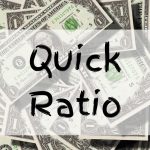Valuation Master Class
VMC: What is the Modigliani–Miller Theorem?
The Modigliani-Miller Theorem suggests that a company’s capital structure and the average cost of capital does not have an impact on its overall value.
Read MoreVMC: What Is Inflation?
Inflation is when the prices of goods and services increase over time. While the prices of goods and services increase, the purchasing power or value of money decreases.
Read MoreVMC: What Is Liabilities to Asset Ratio?
The liabilities to assets ratio is also known as the debt to asset ratio. It shows the percentage of assets that are being funded by debt.
Read MoreVMC: What Is EBIT Margin?
EBIT margin stands for Earning Before Interest and Tax margin. This margin helps stakeholders understand the cost of running the firms as well as profitability.
Read MoreVMC: What Is Quick Ratio?
The quick ratio is a liquidity ratio that measures a firm’s ability to pay its short term liabilities with its most liquid assets.
Read MoreVMC: What is the Gordon Growth Model?
The Gordon growth model, or GGM, is used to calculate the intrinsic value of a stock from future dividends. The model only works for companies that pay out dividends, which have a constant growth rate.
Read MoreVMC: What Is Optimal Capital Structure?
The optimal capital structure of a firm is the right combination of equity and debt financing. It allows the firm to have a minimum cost of capital while having the maximum market value.
Read MoreVMC: What Is Cost of Equity?
To compensate for the risks that shareholders take, firms pay them in return. The theoretical return the firm pays its shareholders is known as the cost of equity. In other words, the cost of equity is the rate of returns a firm pays to its shareholders.
Read MoreVMC: What Is Assets To Equity Ratio?
The assets to equity ratio allow you to understand to what extent a business is funded by equity or debt.
Read MoreVMC: What is the Agency Problem?
Within corporate finance, the agency problem is considered as the conflict of interest between the company’s managers and its stockholders.
Read More









